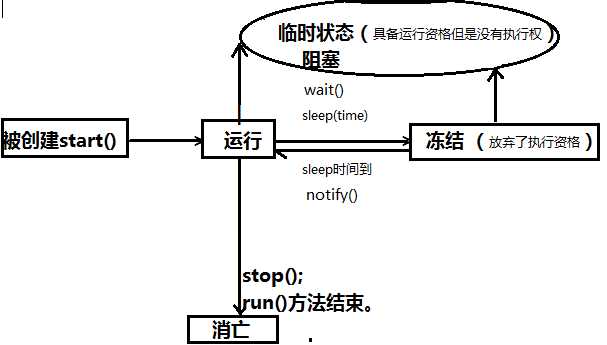标签:
1.多线程概述
进程:是一个正在执行中的程序。
每一个进程都有一个执行单元。该顺序是一个执行路径,或者叫一个控制单元。
线程:就是进程中的一个独立的控制单元。
线程在控制着进程的执行。
一个进程中至少有一个线程。
Java VM 启动的时候会有一个进程 java.exe
该进程中至少一个线程负责java程序的执行。
而且这个线程运行的代码存在于main方法中。
该线程称之为主线程。
扩展:其实更细节说明jvm, jvm启动不止一个线程,还有负责垃圾回收机制的线程。
2.创建线程-继承Thread类
通过API的查找,java已经提供了对线程这类事物的描述。就是Thread类。
创建线程的第一种方式:继承Thread类。
步骤:
1.定义类继承Thread。
2.复写Thread类中的run方法。
目的:将自定义的代码存储在run方法,让线程运行。
3.调用线程的start方法。
该方法有两个作用:启动线程,调用run方法。
//继承Thread类
class Demo extends Thread
{
public void run()
{
for(int i=0; i < 100; i++)
{
System.out.println("demo "+i);
}
}
}
public class ThreadDemo
{
public static void main(String[] args)
{
Demo d = new Demo();//创建一个线程
d.start();//开启线程并执行线程的run方法
//d.run(); //仅仅是对象调用方法。而线程创建了,并没有运行。
for(int i = 0; i < 100; i++)
{
System.out.println("hello "+i);
}
//Thread t = new Thread();
//t.start();
}
}
发现运行结果每一次都不同。
因为多个线程都获取cpu的执行权。cpu执行到谁, 谁就运行。
明确一点,在某一个时刻,只能有一个程序在运行(多核除外)
cpu在做着快速的切换,以达到看上去是同时运行的效果。
我们可以形象的把多线程的运行行为看做在互相抢夺cpu的执行权。
这就是多线程的一个特性:随机性。谁抢到谁执行,至于执行多长,cpu说的算。
3.创建线程-run和start特点
为什么要覆盖run方法?
Thread类同于描述线程。
该类就定义了一个功能,用于存储线程要运行的代码,该存储功能就是run方法。
也就是说Thread类中的run方法,用于存储线程要运行的代码。
d.start();//开启线程并执行该线程的run方法
d.run(); //仅仅是对象调用方法。而线程创建了,并没有运行。
4.多线程(线程练习)
创建两个线程,和主线程交替运行。
class Test extends Thread
{
private String id;
Test(String id)
{
this.id = id;
}
public void run()
{
for(int i = 0; i < 50; i++)
System.out.println("test "+id+" "+i);
}
}
public class ThreadTest
{
public static void main(String[] args)
{
Test t1 = new Test("111");
Test t2 = new Test("222");
t1.start();
t2.start();
for(int i = 0; i < 50; i++)
System.out.println("main "+i);
}
}
5.线程运行状态
6.获取线程对象以及名称
线程都有自己的默认的名称。
Thread-编号 该编号从0开始
static Thread currentThread() // 获取当前线程对象
getName(); //获取线程名称
设置线程名称:setName或者构造函数。
class Test extends Thread
{
private String id;
Test()
{
}
Test(String name)
{
super(name); //设置线程名称
}
public void run()
{
for(int i = 0; i < 50; i++)
{
System.out.println(this.getName()+" "+i);
//System.out.println(Thread.currentThread().getName()+" "+i);
}
}
}
public class ThreadTest
{
public static void main(String[] args)
{
Test t1 = new Test("hello111");
Test t2 = new Test("hello222");
t1.start();
t2.start();
for(int i = 0; i < 50; i++)
System.out.println("main "+i);
}
}
7.售票的例子
需求:简单的卖票程序。
多个窗口
卖票。
8.创建线程-实现Runnable接口
需求:简单的卖票程序。
多个窗口同时卖票。
创建线程的第二种方式:实现Runable接口
步骤:
1.定义类实现Runnable接口
2.覆盖Runnable接口中的run方法。
将线程要运行的代码存在该run方法中
3.通过Thread类建立线程对象。
4.将Runnable接口的子类对象作为实际参数传递给Thread类的构造函数。
为什么要将Runnable接口的子类对象传递给Thread的构造函数?
因为自定义的run方法所属的对象是Runnable接口的子类对象。
所以要让线程去执行指定对象的run方法。就必须明确该run方法所属的对象
5.调用Thread类的start方法开启线程并调用Runnable接口子类的run方法。
实现方式和继承方式有什么区别
实现方式的好处:避免了单继承的局限性
在定义线程时,建议使用实现方式。
两种方式区别:
继承Thread:线程代码存放Thread子类方法中。
实现Runnable,线程代码存在接口子类的run方法中。
class Ticket implements Runnable//extends Thread
{
private int tick = 100;
public void run()
{
while(true)
{
if(tick>0)
{
System.out.println(Thread.currentThread().getName()+"....sale : "+ tick--);
}
}
}
}
class TicketDemo
{
public static void main(String[] args)
{
Ticket t = new Ticket();
Thread t1 = new Thread(t);//创建了一个线程;
Thread t2 = new Thread(t);//创建了一个线程;
Thread t3 = new Thread(t);//创建了一个线程;
Thread t4 = new Thread(t);//创建了一个线程;
t1.start();
t2.start();
t3.start();
t4.start();
/*
Ticket t1 = new Ticket();
//Ticket t2 = new Ticket();
//Ticket t3 = new Ticket();
//Ticket t4 = new Ticket();
t1.start();
t1.start();
t1.start();
t1.start();
*/
}
}
9.多线程的安全问题
多线程的运行出现了安全问题。
问题的原因:
当多条语句在操作同一个线程共享数据时,一个线程对多条语句只执行了一部分,还没有执行完,
另一个线程参与进来执行。导致共享数据的错误。
解决办法:
对多条操作共享数据的语句,只能让一个线程都执行完。在执行过程中,其他线程不可以参与执行。
10.多线程同步代码块
卖票
Java对于多线程的安全问题提供了专业的解决方式。
就是同步代码块。
synchronized(对象)
{
需要被同步的代码
}
对象如同锁,持有锁的线程可以在同步中执行。
没有持有锁的线程即使获取cpu的执行权,也进不去,因为没有获取锁。
火车上的卫生间----经典。
同步的前提;
1.必须要有两个或者两个以上的线程。
2.必须是多个线程使用同一个锁。
必须保证同步中只能有一个线程在运行。
好处:解决了多线程的安全问题。
弊端:多个线程需要判断锁,较为消耗资源。
class Ticket implements Runnable
{
private int tick = 1000;
Object obj = new Object();
public void run()
{
while(true)
{
synchronized(obj)
{
if(tick>0)
{
//try{Thread.sleep(10);}catch(Exception e){}
System.out.println(Thread.currentThread().getName()+"....sale : "+ tick--);
}
}
}
}
}
class TicketDemo2
{
public static void main(String[] args)
{
Ticket t = new Ticket();
Thread t1 = new Thread(t);
Thread t2 = new Thread(t);
Thread t3 = new Thread(t);
Thread t4 = new Thread(t);
t1.start();
t2.start();
t3.start();
t4.start();
}
}
11.同步函数
如何找问题
1.明确哪些代码时多线程运行代码
2.明确共享数据
3.明确多线程运行代码中哪些语句是操作共享数据的。
/*
需求:
银行有一个金库。
有两个储户分别存300员,每次存100,存3次。
目的:该程序是否有安全问题,如果有,如何解决?
*/
class Bank
{
private int sum;
//Object obj = new Object();
public synchronized void add(int n)
{
//synchronized(obj)
//{
sum = sum + n;
try{Thread.sleep(10);}catch(Exception e){}
System.out.println("sum="+sum);
//}
}
}
class Cus implements Runnable
{
private Bank b = new Bank();
public void run()
{
for(int x=0; x<3; x++)
{
b.add(100);
}
}
}
class BankDemo
{
public static void main(String[] args)
{
Cus c = new Cus();
Thread t1 = new Thread(c);
Thread t2 = new Thread(c);
t1.start();
t2.start();
}
}
12.多线程-同步函数的锁是this
函数需要被对象调用,那么函数都有一个所属对象引用。就是this
所以同步函数使用的锁是this。
通过该程序进行验证。
使用两个线程来买票。
一个线程在同步代码块中。
一个线程在同步函数中。
都在执行卖票动作。
代码:
class Ticket implements Runnable
{
private int tick = 100;
Object obj = new Object();
boolean flag = true;
public void run()
{
if(flag)
{
while(true)
{
synchronized(this)
{
if(tick>0)
{
try{Thread.sleep(10);}catch(Exception e){}
System.out.println(Thread.currentThread().getName()+"....code : "+ tick--);
}
}
}
}
else
while(true)
show();
}
public synchronized void show()//this
{
if(tick>0)
{
try{Thread.sleep(10);}catch(Exception e){}
System.out.println(Thread.currentThread().getName()+"....show.... : "+ tick--);
}
}
}
class ThisLockDemo
{
public static void main(String[] args)
{
Ticket t = new Ticket();
Thread t1 = new Thread(t);
Thread t2 = new Thread(t);
t1.start();
try{Thread.sleep(10);}catch(Exception e){}
t.flag = false;
t2.start();
}
}
13.静态同步函数的锁是Class对象
如果同步函数被静态修饰后,使用的锁是什么?
通过验证,发现不再是this,因为静态方法中也不可以定义this。
静态进内存时,内存中没有本类对象,但是一定有该类对应的字节码文件对象。
类名.class 该对象的类型是Class
静态的同步方法,使用的锁是该方法所在类的字节码文件对象。 类名.class
示例代码:
class Ticket implements Runnable
{
private static int tick = 100;
//Object obj = new Object();
boolean flag = true;
public void run()
{
if(flag)
{
while(true)
{
synchronized(Ticket.class)
{
if(tick>0)
{
try{Thread.sleep(10);}catch(Exception e){}
System.out.println(Thread.currentThread().getName()+"....code : "+ tick--);
}
}
}
}
else
while(true)
show();
}
public static synchronized void show()
{
if(tick>0)
{
try{Thread.sleep(10);}catch(Exception e){}
System.out.println(Thread.currentThread().getName()+"....show.... : "+ tick--);
}
}
}
class StaticMethodDemo
{
public static void main(String[] args)
{
Ticket t = new Ticket();
Thread t1 = new Thread(t);
Thread t2 = new Thread(t);
t1.start();
try{Thread.sleep(10);}catch(Exception e){}
t.flag = false;
t2.start();
}
}
14.单例设计模式-懒汉式
class Single
{
public static void main(String[] args)
{
private static Single s = null;
private Single(){}
public static Single getInstance()
{
if(s == null)//优化速度 减少锁的判断
{
synchronized(Single.class)//静态函数中
{
if(s == null)
s = new Single();
}
}
return s;
}
}
}
15.多线程-死锁
同步中嵌套同步,但是锁不同
示例代码:
class Ticket implements Runnable
{
private int tick = 1000;
Object obj = new Object();
boolean flag = true;
public void run()
{
if(flag)
{
while(true)
{
synchronized(obj)
{
show();
}
}
}
else
while(true)
show();
}
public synchronized void show()//this
{
synchronized(obj)
{
if(tick>0)
{
try{Thread.sleep(10);}catch(Exception e){}
System.out.println(Thread.currentThread().getName()+"....code : "+ tick--);
}
}
}
}
class DeadLockDemo
{
public static void main(String[] args)
{
Ticket t = new Ticket();
Thread t1 = new Thread(t);
Thread t2 = new Thread(t);
t1.start();
try{Thread.sleep(10);}catch(Exception e){}
t.flag = false;
t2.start();
}
}
04-java学习笔记-多线程1
标签:
原文地址:http://www.cnblogs.com/chasingw/p/4849433.html
